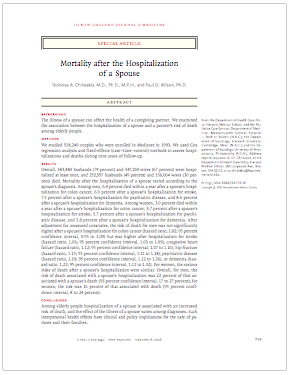
Mortality After the Hospitalization of a Spouse
Abstract
Background: The illness of a spouse can affect the health of a caregiving partner. We examined the association between the hospitalization of a spouse and a partner's risk of death among elderly people.
Methods: We studied 518,240 couples who were enrolled in Medicare in 1993. We used Cox regression analysis and fixed-effects (case–time–control) methods to assess hospitalizations and deaths during nine years of follow-up.
Results: Overall, 383,480 husbands (74 percent) and 347,269 wives (67 percent) were hospitalized at least once, and 252,557 husbands (49 percent) and 156,004 wives (30 percent) died. Mortality after the hospitalization of a spouse varied according to the spouse's diagnosis. Among men, 6.4 percent died within a year after a spouse's hospitalization for colon cancer, 6.9 percent after a spouse's hospitalization for stroke, 7.5 percent after a spouse's hospitalization for psychiatric disease, and 8.6 percent after a spouse's hospitalization for dementia. Among women, 3.0 percent died within a year after a spouse's hospitalization for colon cancer, 3.7 percent after a spouse's hospitalization for stroke, 5.7 percent after a spouse's hospitalization for psychiatric disease, and 5.0 percent after a spouse's hospitalization for dementia. After adjustment for measured covariates, the risk of death for men was not significantly higher after a spouse's hospitalization for colon cancer (hazard ratio, 1.02; 95 percent confidence interval, 0.95 to 1.09) but was higher after hospitalization for stroke (hazard ratio, 1.06; 95 percent confidence interval, 1.03 to 1.09), congestive heart failure (hazard ratio, 1.12; 95 percent confidence interval, 1.07 to 1.16), hip fracture (hazard ratio, 1.15; 95 percent confidence interval, 1.11 to 1.18), psychiatric disease (hazard ratio, 1.19; 95 percent confidence interval, 1.12 to 1.26), or dementia (hazard ratio, 1.22; 95 percent confidence interval, 1.12 to 1.32). For women, the various risks of death after a spouse's hospitalization were similar. Overall, for men, the risk of death associated with a spouse's hospitalization was 22 percent of that associated with a spouse's death (95 percent confidence interval, 17 to 27 percent); for women, the risk was 16 percent of that associated with death (95 percent confidence interval, 8 to 24 percent).
Conclusions: Among elderly people hospitalization of a spouse is associated with an increased risk of death, and the effect of the illness of a spouse varies among diagnoses. Such interpersonal health effects have clinical and policy implications for the care of patients and their families.
Citation:
N.A. Christakis and P.D. Allison, "Mortality After the Hospitalization of a Spouse" New England Journal of Medicine, 354(7): 719-730 (February 2006)